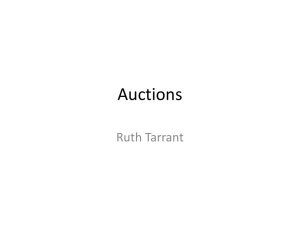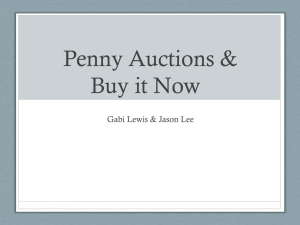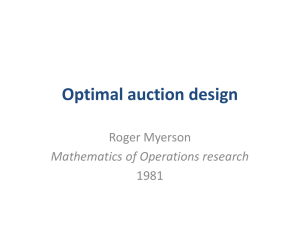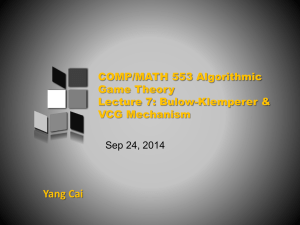Theory, Models, and Applications, Part 6
advertisement
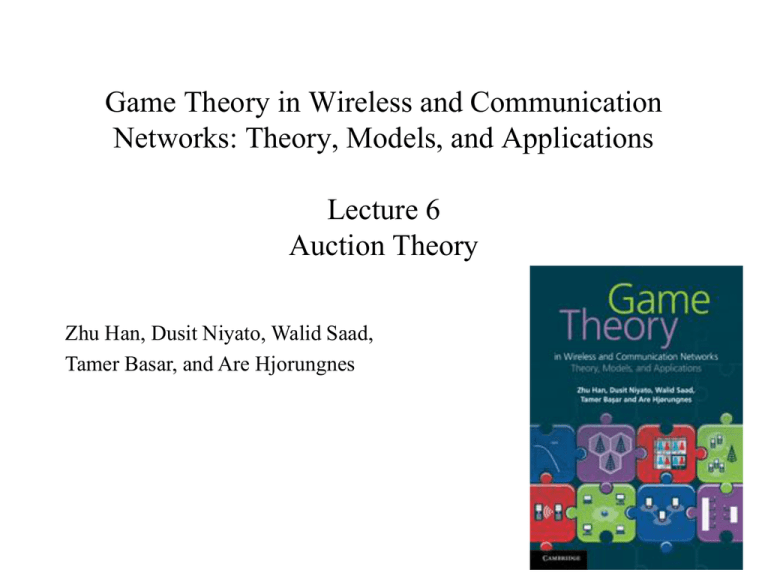
Game Theory in Wireless and Communication Networks: Theory, Models, and Applications Lecture 6 Auction Theory Zhu Han, Dusit Niyato, Walid Saad, Tamer Basar, and Are Hjorungnes Overview of Lecture Notes Introduction to Game Theory: Lecture 1 Noncooperative Game: Lecture 1, Chapter 3 Bayesian Game: Lecture 2, Chapter 4 Differential Game: Lecture 3, Chapter 5 Evolutional Game : Lecture 4, Chapter 6 Cooperative Game: Lecture 5, Chapter 7 Auction Theory Lecture 6, Chapter 8 Total Lectures are about 8 Hours Outline Introduction and auction basics Mechanism design Special auctions – – – – – – – VCG auction Share auction Double auction Sequential first-price auction AGV auction Ascending clock auction (Reverse) combinatorial auction Summary Introduction A market mechanism in which an object, service, or set of objects, is exchanged on the basis of bids submitted by participants. An auction provides a specific set of rules that will govern the sale or purchase (procurement auction) of an object to the submitter of the most favorable bid. Typical auctions – First-price auction – Second-price auction – English auction – Dutch auction – Japanese auction – All-pay actions – Unique bid auction – Generalized second-price auction Properties of Auctions Allocative efficiency means that in all these auctions the highest bidder always wins (i.e., there are no reserve prices). It is desirable for an auction to be computationally efficient. Revenue Equivalence Theorem: Any two auctions such that: – The bidder with the highest value wins – The bidder with the lowest value expects zero profit – Bidders are risk-neutral 1 – Value distributions are strictly increasing and atomless have the same revenue and also the same expected profit for each bidder. The theorem can help find some equilibrium strategy. Mechanism Design Definition of Mechanism Design goal and properties The objective of a mechanism M = (S, g) is to achieve the desired game outcome Desired properties – Efficiency: select the outcome that maximizes total utility. – Fairness: select the outcome that achieves a certain fairness criterion in utility. – Revenue maximization: select the outcome that maximizes revenue to a seller (or more generally, utility to one of the players). – Budget-balanced: implement outcomes that have balanced transfers across players. – Pareto optimality Equilibrium concepts Rationality Concepts DRM, Incentive Compatible and Strategy Proof Revelation Principle For any Bayesian Nash equilibrium there corresponds a Bayesian game with the same equilibrium outcome but in which players truthfully report type. Allows one to solve for a Bayesian equilibrium by assuming all players truthfully report type (subject to an incentivecompatibility constraint), which eliminates the need to consider either strategic behavior or lying. no matter what the mechanism, a designer can confine attention to equilibria in which players truthfully report type. Theorem: For any mechanism, M, there is a direct, incentivecompatible mechanism with the same outcome. – Incentive compatible is free – Fancy mechanisms are unnecessary Budget Balance Transfer or side payment Budget balance Efficiency Groves Mechanisms Impossibility and Possibility Outline Introduction and auction basics Mechanism design Special auctions – – – – – – – VCG auction Share auction Double auction Sequential first-price auction AGV auction Ascending clock auction Reverse combinatorial auction Summary VCG Auction Vickrey auction is a type of sealed-bid auction, in which bidders (players) submit written bids without knowing the bid of the other people in the auction. The highest bidder wins, but the price paid is the second-highest bid. In other words, the payment equals to the performance loss of all other users because of including user i . Truthful relevance, ex post efficient, and strategy proof VCG Example Shortcoming of VCG It does not allow for price discovery - that is, discovery of the market price if the buyers are unsure of their own valuations - without sequential auctions. Sellers may use shill bids to increase profit. In iterated Vickrey auctions, the strategy of revealing true valuations is no longer dominant. It is vulnerable to collusion by losing bidders. It is vulnerable to shill bidding with respect to the buyers. It does not necessarily maximize seller revenues; seller revenues may even be zero in VCG auctions. If the purpose of holding the auction is to maximize profit for the seller rather than just allocate resources among buyers, then VCG may be a poor choice. The seller's revenues are non-monotonic with regard to the sets of bidders and offers. Share Auction A share auction is concerned with allocating a perfect divisible good among a set of bidders. Share Auction Mechanism: Share Auction Double Auction A double auction is a process of buying and selling goods when potential buyers submit their bids and potential sellers simultaneously submit their ask prices to an auctioneer, and then an auctioneer chooses some price p that clears the market: all the sellers who asked less than p sell and all buyers who bid more than p buy at this price p. Double Auction Buyer utility Seller utility Optimization Double Auction Sequential First/Second-Price Auction In multi-object auctions, multiple objects are put up for auction and multiple winners emerge. – substitutable auctions: different objects have same value for specific bidder. – non-substitutable auctions: the values of different objects are different The winners of the items sequentially decided in multiple rounds. In each round, each bidder can submit only one bid for a specific object and only the winners of the bided items are decided. Sequential auctions require less information exchange among the auctioneer and bidders, and provide high flexibility for the bidders and high revenue for the auctioneer. Sequential First/Second-Price Auction The sequential first price auction is a situation in which the M object are sold to N > M bidders using a series of first-price sealed bid auctions. – Specifically, in each round, each bidder bids for a specific item, and for each item that is bided by at least one bidder, the item is obtained by the bidder with the highest bid at the price of its submitted bid. The only difference for the sequential second price auction is that, in each round, the winner obtains the item at the price of the second highest bid, instead of its submitted bid. AGV Auction AGV(Arrow-d’Aspremont-Gerard-Varet) mechanism is an extension of the Groves mechanism, – Incentive Compatibility, Individual Rationality and Budget Balance – “Expected form” of the Groves mechanisms – The allocation rule is the same as VCG. Ascending Clock Auction During the auction, the auctioneer first announces a initial price, then the bidders report to the auctioneer their demands at that price, and the auctioneer raises the price until the total demands meet the supply. – Distributed approach – Single object pay-as-bid ascending clock auction, in which the good is sold as a single object and the bidder can only bid 0 or p – Traditional ascending clock auction, where each bidder is allowed to bid between 0 and p at every iteration. Distributed dual-based optimization approach for Network Utility Maximization problem (Reverse) Combinatorial Auction Combinatorial auctions (CAs) are multi-item auctions in which bidders can place bids on combinations of items called packages or bundles, rather than just on individual item. – Pricing and bidding strategies – Winner determination problem Reverse CA game – The auctioneer first announces an initial price – The bidders submit bids corresponding to the current price – A bidder should determine a bid for every package he is interested in. – The auctioneer collects bids and finds the highest utility. If the highest utility is non-negative, the auctioneer is willing to sell the items, otherwise, he will not sell them. – Then the auctioneer reduces the price and the auction moves to the next round. – When stopping rules are satisfied, the auction is concluded. Summary Auctions take many forms but always satisfy two conditions: – They may be used to sell any item and so are universal, also – The outcome of the auction does not depend on the identity of the bidders; i.e., auctions are anonymous. Properties – efficiency of a given auction design – optimal and equilibrium bidding strategies – revenue comparison. Winner curse – winner will frequently have bid too much for the auctioned item. Many applications in wireless networking



